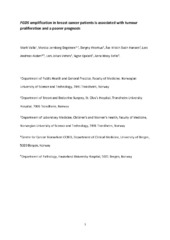FGD5 amplification in breast cancer patients is associated with tumor proliferation and a poorer prognosis
Valla, Marit; Engstrøm, Monica J; Ytterhus, Borgny; Hansen, Åse Kristin Skain; Akslen, Lars A.; Vatten, Lars Johan; Opdahl, Signe; Bofin, Anna M.
Peer reviewed, Journal article
Accepted version

View/
Date
2017-04Metadata
Show full item recordCollections
Original version
https://doi.org/10.1007/s10549-017-4125-8Abstract
Purpose: Proliferation is a hallmark of cancer. Using a combined genomic approach, FGD5 amplification has been identified as a driver of proliferation in Luminal breast cancer. We aimed to describe FGD5 copy number change in breast cancer, and to assess a possible association with tumour proliferation and prognosis. Methods: We used fluorescence in situ hybridization targeting FGD5 and chromosome 3 centromere (CEP3) on formalin-fixed, paraffin-embedded tissue from 430 primary breast cancers and 108 lymph node metastases, from a cohort of Norwegian breast cancer patients. We tested the association between FGD5 copy number status and proliferation (assessed by Ki67 levels and mitotic count) using Pearson’s Chi square test, and assessed the prognostic impact of FGD5 copy number change by estimating cumulative risks of death and hazard ratios. Results: We identified FGD5 amplification (defined as FGD5/CEP3 ratio ≥2 or mean FGD5/tumour cell ≥4) in 9.5% of tumours. Mitotic count and Ki67 levels were higher in tumours with FGD5 copy number increase, compared to tumours with no copy number change. After 10 years of follow-up, cumulative risk of death from breast cancer was higher among cases with FGD5 amplification [48.1% (95% CI 33.8–64.7)], compared to non-amplified cases [27.7% (95% CI 23.4–32.6)]. Conclusions: FGD5 is a new prognostic marker in breast cancer, and increased copy number is associated with higher tumour proliferation and poorer long-term prognosis.